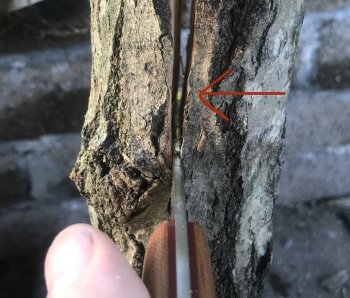You are using an out of date browser. It may not display this or other websites correctly.
You should upgrade or use an alternative browser.
You should upgrade or use an alternative browser.
Bushcraft heat treat
- Thread starter D Whitt
- Start date
tkroenlein
Well-Known Member
I really wanted to speak up when this was posted but thought it better to hold my peace for fear of offending someone. But conversation isn't possible when no one speaks up. So I don't intend to offend or start an argument on the finer points of knife design. I'm not a pro, and there are lots of people here that know a lot more than me. So this is what I do and why I do it based on what I know or understand at this point in my knife making journey.
3 points I consider about steel. Strength, toughness, wear resistance. For me, less with the wear resistance because I haven't moved my heat treating capabilities into high carbide volume steels.
The strongest condition for steel is fully hardened. But it's brittle. So we temper it down to raise the toughness. And it doesn't take a lot of tempering, relatively speaking, to raise that toughness dramatically. Somewhere along the way of tempering, hardness and toughness are at their maximum values relative to the other. That happens to be a good starting point each for knives, give or take a little each way for given a use.
Now if you've handled steel in its annealed state, you've noticed how easy it is to bend. This is basically a pearlite state. Toughness is very high, but hardness (strength) is very low. This is what the unquenched portion of an edge quench produces. This steel will deform, ding, roll, and take a set if bent. The hardened edge will be tempered martensite, which is the ideal condition for knives. It is the most resistant to deformation, has the much higher strength, and best wear resistance.
In an earlier reply above, @J. Doyle mentioned fully quenching then selectively tempering the spine. That's because that tempered martensite will be much stronger than the pearlite left from an edge quenched blade. It won't be as strong as the edge, but will be much tougher while not being so prone to taking a set. In fact, if done properly, will very nearly be a perfect spring.
So, for my own purposes, I've stuck with fully hardened blades at the top end of the hardness for the given steel. This gives me the highest attainable strength, which not only aids in edge holding, it requires the most force to break (I think force is the right word.) Also, a rolled edge can be a point of propagation for ultimate blade failure, which is also (and maybe greater) consideration when considering something like batoning with a bushcraft knife.
I'll leave you with a picture, because everyone likes pictures. This is my personal Kephart in 1/8" 52100, FFG, slight distal taper at 61.5 HRC. It is wedged into a knot I was splitting down. I could not get it pounded through from either direction, but it didn't bend, break, or roll during the attempt.

3 points I consider about steel. Strength, toughness, wear resistance. For me, less with the wear resistance because I haven't moved my heat treating capabilities into high carbide volume steels.
The strongest condition for steel is fully hardened. But it's brittle. So we temper it down to raise the toughness. And it doesn't take a lot of tempering, relatively speaking, to raise that toughness dramatically. Somewhere along the way of tempering, hardness and toughness are at their maximum values relative to the other. That happens to be a good starting point each for knives, give or take a little each way for given a use.
Now if you've handled steel in its annealed state, you've noticed how easy it is to bend. This is basically a pearlite state. Toughness is very high, but hardness (strength) is very low. This is what the unquenched portion of an edge quench produces. This steel will deform, ding, roll, and take a set if bent. The hardened edge will be tempered martensite, which is the ideal condition for knives. It is the most resistant to deformation, has the much higher strength, and best wear resistance.
In an earlier reply above, @J. Doyle mentioned fully quenching then selectively tempering the spine. That's because that tempered martensite will be much stronger than the pearlite left from an edge quenched blade. It won't be as strong as the edge, but will be much tougher while not being so prone to taking a set. In fact, if done properly, will very nearly be a perfect spring.
So, for my own purposes, I've stuck with fully hardened blades at the top end of the hardness for the given steel. This gives me the highest attainable strength, which not only aids in edge holding, it requires the most force to break (I think force is the right word.) Also, a rolled edge can be a point of propagation for ultimate blade failure, which is also (and maybe greater) consideration when considering something like batoning with a bushcraft knife.
I'll leave you with a picture, because everyone likes pictures. This is my personal Kephart in 1/8" 52100, FFG, slight distal taper at 61.5 HRC. It is wedged into a knot I was splitting down. I could not get it pounded through from either direction, but it didn't bend, break, or roll during the attempt.

Last edited:
Doug Lester
Well-Known Member
Nice knife. A little small to go splitting your firewood with but I've always been of the philosophy that if you need a knife then get at knife, and if you need a hatchet to get a hatchet.
Doug
Doug
